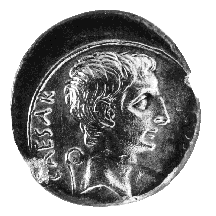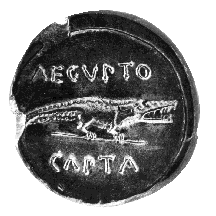



(62) Octavian - AR denarius, 28 B.C., 3.58 g. (inv. 91.113).
Obverse: Bare head of Octavian r.; behind, lituus; CAESAR CO(N)S(VL)
[VI]: Caesar, consul for the sixth time.
Reverse: Crocodile r.; AEGVPTO CAPTA: Egypt captured.
Provenance: Edward Gans, 1959.
Bibliography: C.H.V. Sutherland, The Roman Imperial Coinage I: from 31
BC to AD 69, rev. ed. (London 1984) 275a.
This denarius celebrates the successful conclusion of Octavian's Egyptian
campaign. The campaign began with the Battle of Actium in 31 B.C., at the
Gulf of Ambracia on the western coast of Greece, in which he defeated the
fleet of his rival Marc Antony and forced Antony and his ally Kleopatra
to flee to Egypt. On August 1, 30 B.C. Octavian's forces entered the Egyptian
capital, Alexandria, where most of Antony's troops surrendered. Antony and
soon after Kleopatra committed suicide, and Octavian became sole ruler of
the Roman world. In 29 B.C. Octavian returned to Rome for his official triumph
(a triple one, primarily celebrating his successes at Actium and Alexandria
but also in Illyricum), and in the following year the crocodile with the
inscription AEGVPTO CAPTA celebrated the event on these denarii,
probably struck at Rome.
The portrait on the obverse is a particularly youthful one. The lituus
behind it, a symbol of the priest as augur or diviner of success
or failure, is often taken to refer to the customary auguries before battle
and thus here probably refers to the anticipated victories in the three
campaigns celebrated in 29 B.C.
C.L.L.



All contents copyright (c) 1996.
Lawrence University
All rights reserved.